This fermented honey garlic is the perfect thing to make to boost your immune system! Both honey and garlic have strong medicinal benefits, so you’ll want to have this delicious home remedy on hand for cold and flu season.
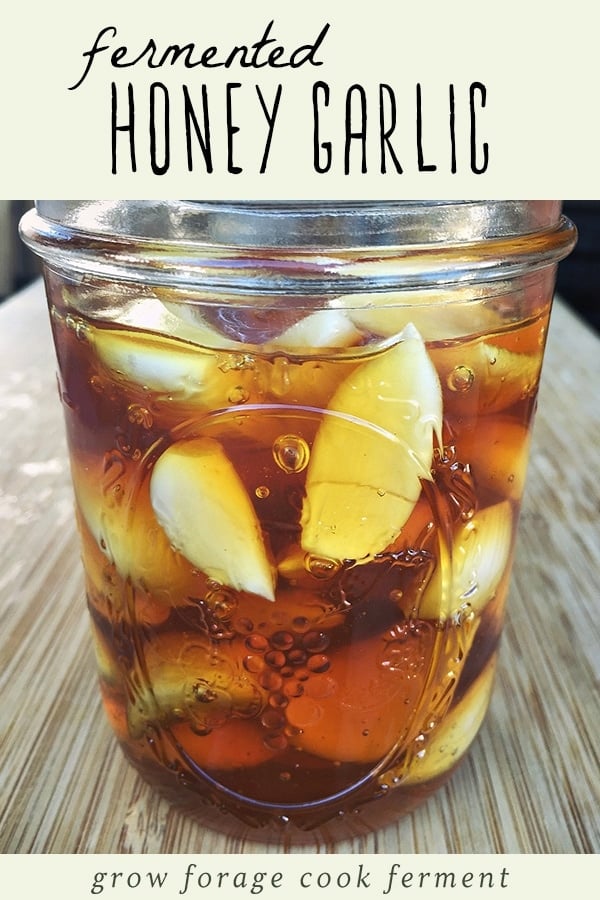
Want to save this post for later?
Fermenting Garlic in Honey
I’m really excited to share this post with you! Fermented honey garlic is something I’ve been wanting to try for a very long time, ever since I first read about it on the Killer Pickles blog.
I usually reserve my honey for mead making, but using it for other ferments intrigued me. Don’t ask me why I haven’t done it until now, because it’s the easiest thing in the world!
This tasty fermented garlic in honey can be used for many things, as good food and good medicine. Honestly though, I like to just eat it as is!
Fermented Honey Garlic Recipe
Making fermented honey garlic is so easy, it hardly needs a recipe!
Prepare the Garlic
The hardest and most time consuming part is prepping all of the garlic. Whatever size jar you use, you’ll want to fill it about 1/2-3/4 full of peeled garlic.
The quickest and easiest way to prep garlic is to place the side of a chef’s knife on top of a single clove and then give it a firm whack with the palm of your hand.
Don’t do it too hard, as you don’t want to crush the garlic, but just enough to lightly bruise the it. This will make it easy to peel, and will also release a bit of the garlic juice.
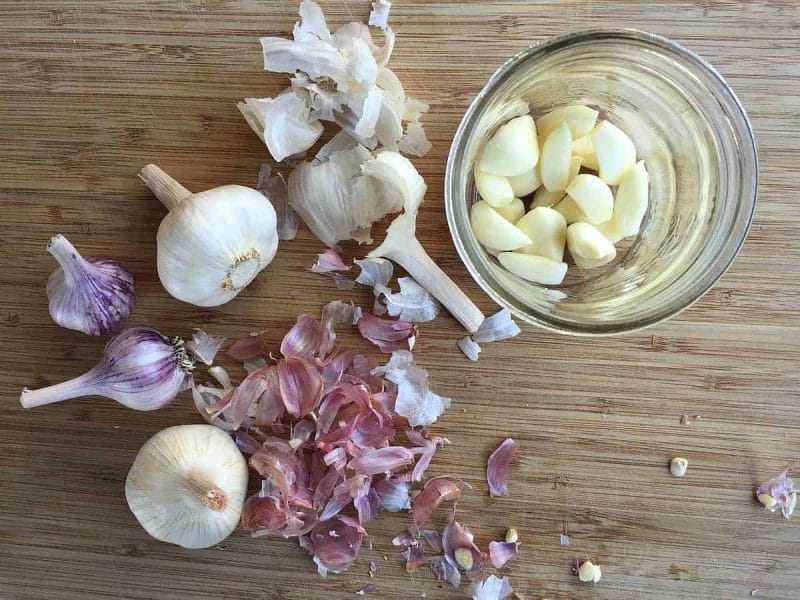
Add the Honey
Once you have enough garlic in your jar, pour in some raw honey to cover it. The garlic will probably float a bit and that’s ok.
It’s important to use raw honey to make fermented garlic in honey, as it will still have all the bacteria and wild yeast that is necessary for fermentation.
When liquid is added to honey, it jump starts the fermentation process. The small amount of juice from the garlic will create just enough liquid for fermentation to happen.
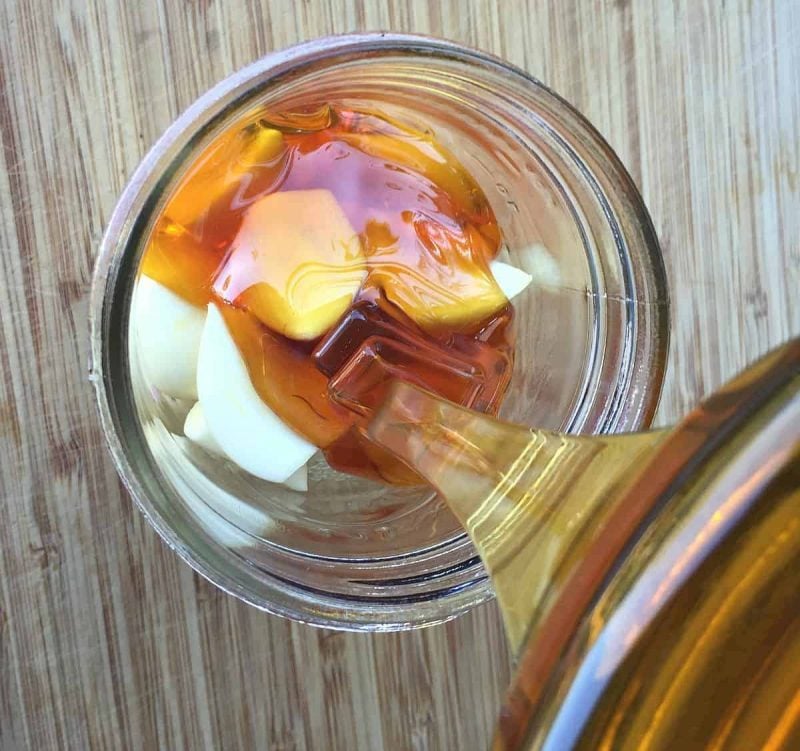
Cover and Flip
Cover the jar loosely with a lid to let the gasses escape, and put it in a dark place to ferment.
It’s a good idea to put a plate or something similar underneath the jar as it’s fermenting, as it will likely bubble up a bit and a little honey could possibly drip out.
It’s also important to gently turn the jar over every day or so, or whenever you think about it, to make sure that all of the garlic stay coated with honey.
Screw the lid on tightly before you do this! Then return it to it’s upright position and re-loosen the lid.
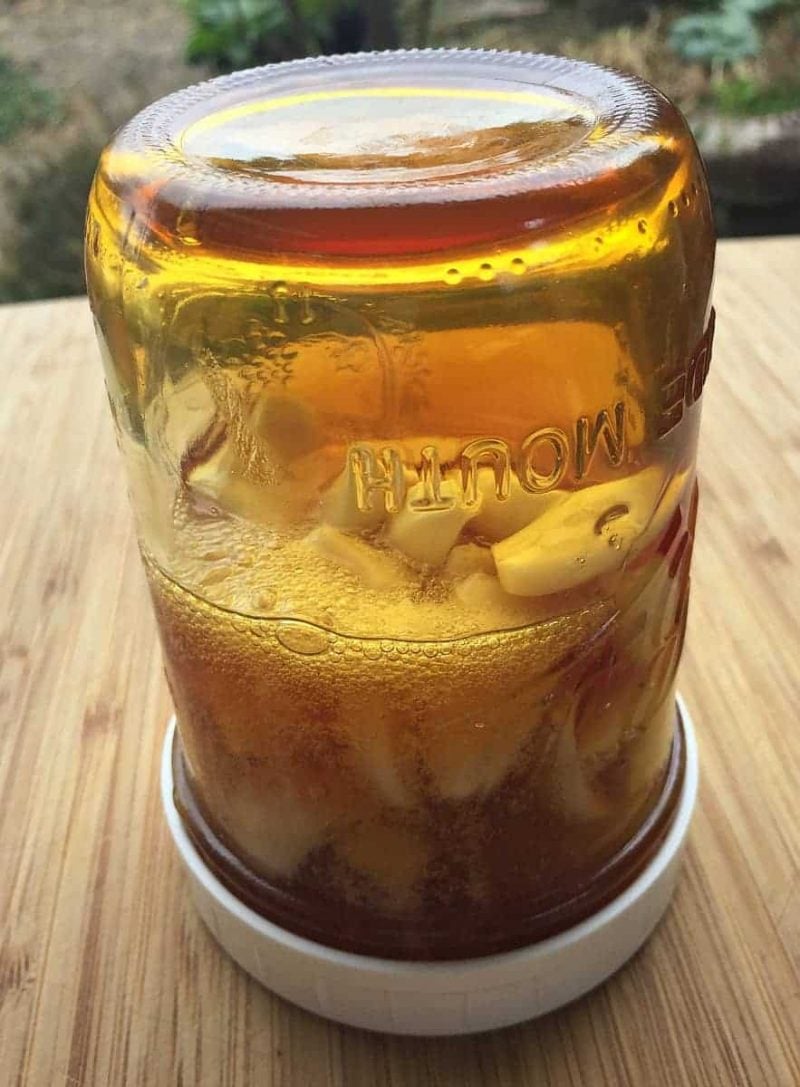
In a few days to a week you will notice some bubbles forming on the surface of the honey. Hooray!
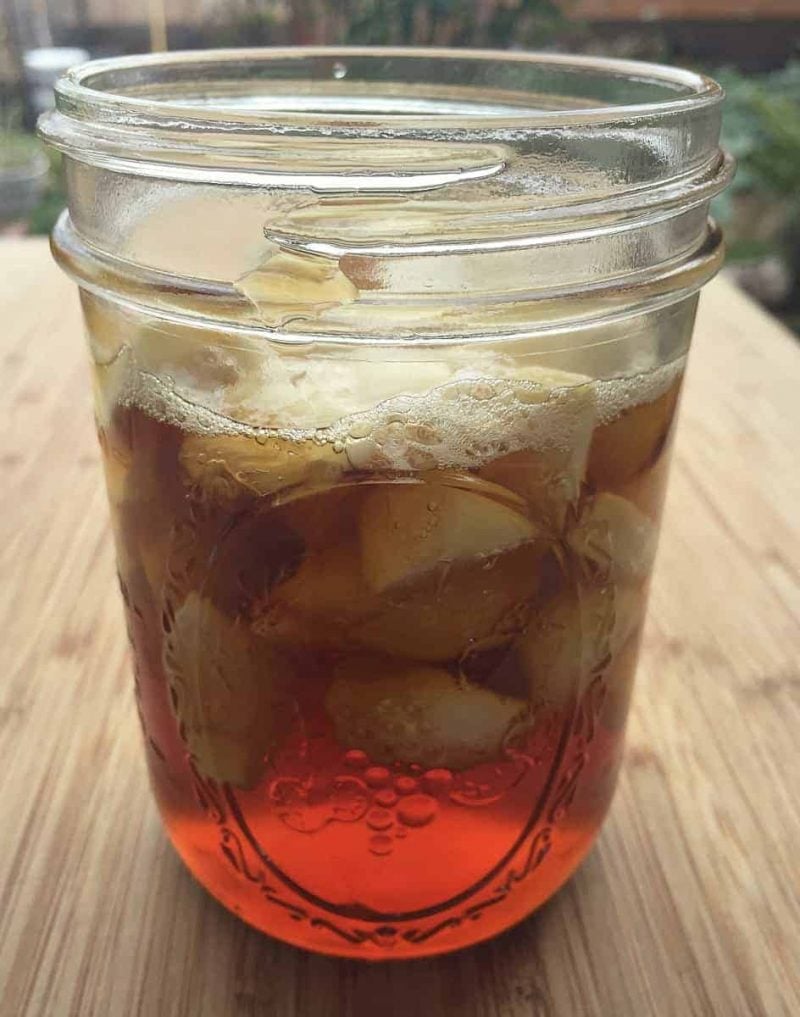
The honey garlic will ferment for about a month, but you can eat it at any time during the process.
The flavor will continue to develop over time, the garlic will mellow, and the honey will become much runnier.
Occasionally the garlic cloves turn a blue or green color due to a reaction during the fermentation process. While it may be a bit alarming, it is not harmful and the honey garlic can still be used.
Honey garlic will store well in a cool place for many months, or even a year or longer! I’ve kept some for over two years and it is still good.
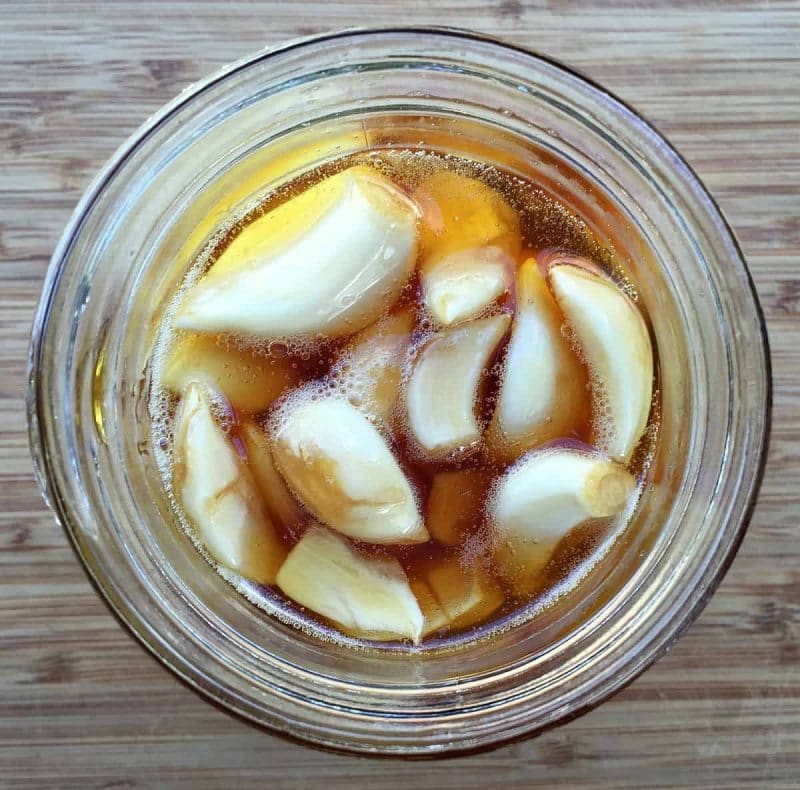
Using Fermented Honey Garlic
Now, how do you use this fermented honey garlic? That’s a good question, and it can be used in a variety of ways.
Both garlic and honey have strong medicinal properties, so it makes sense to use it as an immune booster or if you feel a cold or flu coming on.
Pop a whole garlic clove, or take a spoonful of honey (or both!).
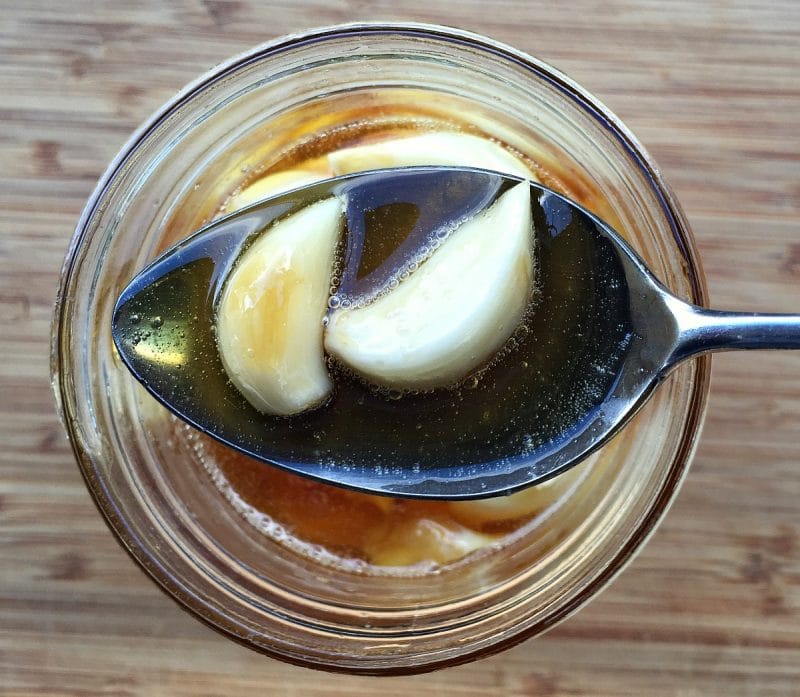
As you can probably imagine, honey garlic also makes a wonderful food!
It’s a natural in marinades and sauces, and would make a really tasty glaze for meats or veggies. Basically anything where you would normally use honey and garlic together!
Is Botulism a Concern in Honey Garlic?
I get this question a lot about fermented honey garlic! The short answer is no, botulism is really not a concern in this type of ferment.
While botulism can happen in garlic and oil preparations without added acidity, the fermentation process that happens here makes it very unlikely.
Raw honey is acidic, and while it can carry botulism spores (which is why it is not recommended for babies under 1 year), the level of acidity stops them from reproducing, which is what causes botulism.
If you are concerned about it, use a pH test strip. Botulism spores can’t reproduce with a pH of less than 4.6. Honey is usually around 3.9, but that can vary between brands.
If the pH is too high, add a splash of raw apple cider vinegar to add more acidity and retest. This is generally not needed, but I did want to mention it.
Honey garlic should not be given to babies under one year of age.
I really hope you make this yummy honeyed garlic! It’s super easy, and great to have on hand. I have a feeling it’s going to become a staple in our house!
Have you ever made fermented honey garlic? How do you use it?
More Fermented and Infused Honey Recipes
Enjoy these other recipes that showcase fermented and infused honey!
- Fermented Honey Cranberries
- Fermented Elderberry Honey
- Herbal Infused Honey
- Lilac Flower Infused Honey
Fermented Honey Garlic
Equipment
Ingredients
- 1 cup whole garlic cloves peeled and slightly crushed
- 1 cup raw honey or more, as needed to cover garlic
Instructions
- Place the peeled garlic cloves into a wide-mouth pint sized mason jar. Add enough honey to completely cover the garlic cloves. Make sure they are coated with honey.
- Place the lid on the jar loosely, then tuck into a dark place.
- Every day or so, tighten the lid on the jar and flip it upside down to coat the garlic cloves with honey. Loosen the lid again when you return it to the upright position.
- Within a few days to a week, you should see small bubbles start to form on the surface of the honey.
- The honey garlic will ferment for about a month, but you can eat it at any time. The flavor will continue to develop over time, the garlic will mellow, and the honey will become much runnier.
- Store in a cool place for many months or even a year, if not longer.
Notes
- It’s important to use raw honey for this recipe, as it has all of the bacteria and wild yeast that is necessary for fermentation.
- The small amount of juice from the garlic will create just enough liquid for fermentation to happen.
- It’s a good idea to put a plate underneath the jar during fermentation, as it will likely bubble up and a little bit of honey could possibly drip out.
- Occasionally the garlic cloves turn a bluish or greenish color during the fermentation process. While it may be a bit alarming, it is not harmful and the honey garlic can still be used.
- If you are concerned about botulism, use a pH test strip. Botulism spores can't reproduce with a pH of less than 4.6. Honey is usually around 3.9, but that can vary between brands.
- If the pH is too high, add a splash of raw apple cider vinegar to add more acidity and retest. This is generally not needed, but I do want to mention it.
- Honey garlic should not be given to babies under one year of age.

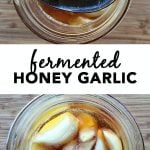
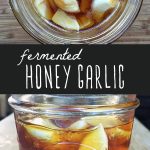
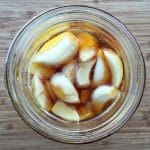

Can you add a couple of teaspoons of fresh squeezed lemon juice at the start?
Sure!
Hello! I want to make this, but I wanted an extra kick, I’ve seen a lot of stuff like this but with chili flakes added in as it’s fermenting. Is that a good idea? I don’t want to mess up the process and I’m not sure how others did it but I’m really intrigued. Thank you!
Hi Haley. Yes, you can totally add in chili flakes or fresh peppers. Check out my jalapeno honey recipe for inspiration.
Hello. Would ground Cinnamon Spice be something good to add? Additional heath benefits and better taste? TIA!
Hi Jim. Yes, you could add cinnamon if you’d like!
Also, tumeric or others? Thank you!
Hi Jim. Yes, you can add whatever herbs you want! Just be aware that only fresh herbs, with their water content, will ferment. Enjoy!
Would it be okay to use already peeled garlic in a bag, that is sold in stores? Or would it be best to buy the bulb and peel it myself?
Hi Amanda. I would probably use unpeeled, organic garlic to be sure it’s uncontaminated with pesticides that could be used to preserve peeled garlic.
That’s what I pretty much figured. I was just hoping to save some time! Thanks for the reply!
Hi! I my fermentation weight that came with my fermenting jar wasn’t quite wide enough to push down the garlic gloves on the sides of the jar, and several gloves (like the top half of the clove) was above the honey for about 24 hrs before I noticed that and stirred it back down with the honey. I’m sure there was a tiny bit of honey on top of the clove but it wasn’t completely submerged. Should I be worried botulism could have grown on the tops of those gloves in that time? And I just mixed it around with the rest of the batch? I know you said to check with a PH strip, and if its under 4.6 then it cant grow, but what if it had already grown, I read that honey wont kill it, that a ph under 4.6 just means more can’t grow. Will ACV splash kill it? Should I be worried? How do I tell? Or am I just over reacting here lol.
Hi Lizzy. I think your honey garlic is likely totally fine. You can add a splash of ACV to regulate the pH if you’re worried, but botulism needs at least a few days to grow so I hardly think you have anything to worry about over only 24 hours.
My Mom was worried about botulism so I added a Tablespoon of Apple Cider Vinegar one day after starting my batch! Will it ferment still? I did 2 cups of Garlic to 3 cups of honey and the one Tbsp of ACV!
Yes, it should still ferment!
Do I need to wash the garlic before putting it into the jar? The garlic bulbs? The individual peeled cloves?
Thanks
Hi there. No, you don’t need to wash the garlic cloves.
Is it possible to add more
Garlic to it as it goes along or do I need to just do a different jar? Thanks
Hi Karen. Because cross-contamination may occur, it’s best practice to always start a new jar.
Thank you for the quick response
I made this Fermented Garlic Honey for the first time last month and I am so happy with it. Raw garlic hurts my stomach but I can enjoy the health benefits of this without trouble and get my children to take it too!! I would like to make an Elderberry tonic with Elderberry syrup being about half of the liquid ingredients, fermented garlic honey another approximate half, and a bit of my homemade ACV too. Can I make each component separately then just combine them all for a finished product? Is it okay to ferment turmeric root and ginger root with the garlic cloves in the raw honey? I would like to add cinnamon and cayenne pepper too. At what point would be best to do that? Thank you very much!!
Hi Alexis! I’m so happy you love the fermented garlic. To answer your questions, yes, you can make them separately and combine them however you want and yes, you can definitely ferment turmeric, ginger, and cinnamon stick with your next batch of fermented garlic. You could add cayenne pepper too, but I’d be careful with raw spices. They may create an unpleasant, chalky texture. How about adding a fresh pepper, like jalapeno? After it all ferments, I would add a splash or two of ACV (or more depending on the viscosity you’re going for). Enjoy!
Thank you so very much for uour advice!!! I am starting a new batch today and am so excited. Hopefully the excitement will last through peeling two quarts of garlic. Lol
Haha, you’re welcome. Enjoy!
Just reading this recipe. It’s sounds wonderful. When completed, is the garlic supposed to be edible as well?
Hi Eva. Yes, definitely. The honey really mellows out the garlic as it ferments.
Can I reuse the honey to make another batch?
Hi Rebecca. It’s not recommended to reuse the honey due to cross-contamination.
This looks amazing! Thanks for sharing this recipe! When flipping the jar upside down, do I leave it for the entire day, a few hours, or do I briefly flip it upside down and then return it to the upright position?
Hi Kelsi. A brief flip to recoat and submerge the garlic is all that’s needed.
I started my jars in early November and keep them in the pantry. I still turn every few days. I ate a piece of garlic with a little honey this evening and it was so tasty. I’m going to try some of the honey with chicken this week. I know it will be delicious.
Yum! I can confirm that ferment honey garlic on chicken is indeed delicious!
Hey,
I would like to add some spices to it prior to it fermenting. Is this safe?
Hi Marcella. Do you mean dried, ground spices? Personally, I would only add dried herbs (after fermentation). Dried ground herbs may create an off, chalky texture (since you won’t be able to stain them out of the honey).
Hi there! After using the honey to ferment garlic can I use it again to start another ferment or do I need to start with fresh garlic every time?
I prefer to start fresh every time. Adding additional garlic to the already fermented garlic is putting your ferment at risk for cross-contamination.
Hi there! Its been 6 months and my honey tastes awesome. I do have a question, is my garlic supposed to look grayish? Is it ok to use?
Yes, it’s totally fine and safe to use.
I used my elephant garlic which seems to be bitter now after the fermenting process. Any other ideas to using the garlic. It doesnt taste too great on its own.
Sorry your garlic seems to be bitter now, Misti. You could try using it in a stir fry with citrus juice or rice vinegar to counteract the bitterness or in hearty soups.
Thank you for this recipe. I switched to the airlocks lids because I was too nervous about the jars possibly exploding from pressure if I forgot to burp them!
I want to give prepared jars to friends and family, but I want it to be *after* the burping stage so they will not have to worry about possible explosion, nor having to remember to burp.
How long before they should be safely past the burping stage? Thanks!
Hi Linda. It really depends on your home’s temperature, but typically honey garlic ferments around a month before all bubbling stops. Enjoy!
I didn’t flip my jars! I did see bubbling for about a week, and flipped the second week. Should I start over?
As long as there isn’t any mold, they should be totally fine!
Some (about a teaspoon) homemade fire cider accidentally spilled into my jar of raw honey (about a quart). As soon as this happened I tried scooping out liquid of fire cider that pooled on the surface on the honey. Within two days the entire jar of honey smelled like the cider vinegar. No change in color, no bubbling, no foaming has occurred in what has no been two weeks since this accident happened. Have I ruined my honey? I realize the taste will always be spicy like fire cider, but is it safe to use? I saw this below in your “fermenting garlic” post. Any additional opinion or comments based on your experience is appreciated, especially since this was a fermented product mixed in with raw honey which may or may not be causing the honey to ferment. I’d just hate to waste all of this raw honey!
If you are concerned about it, use a pH test strip. Botulism spores can’t reproduce with a pH of less than 4.6. Honey is usually around 3.9, but that can vary between brands.
If the pH is too high, add a splash of raw apple cider vinegar to add more acidity and retest. This is generally not needed, but I did want to mention it.
Also to ask a question from your reply to a previous comment, do I have a oxymel here in reversed proportions? Does proportion matter? Is whatever I have created still safe to use?
Thank you!
Hi, Amy. I think your fermented garlic is likely totally fine and safe to use. I don’t believe the addition of vinegar would inhibit the honey from fermenting and even if it stop fermenting, it’s completely fine as long as there’s no mold. To answer your second question, an oxymel is typically equal parts vinegar and honey, so it’s similar, yes, but unfermented.
Just finished my first pint of garlic fermented honey and it was great.
After 2 months was mellow and great tasting.
But don’t know what to do with the honey left. Can it stay on the shelf or should I refrigerate it before using.
Great info. Thanks, Mike
Hi Mike. Honey is shelf-stable for months, if not years, without refrigeration.
Hello- I have a question for you. I fermented pure honey with herbs, garlic let sit close to 3 months. Now I drained it kept the just the honey was going to put in frig. Is it safe? I tasted it and looks good. I have read fermentation suppose to be only 1 month.
Hi Angie. Yes, it’s likely safe. Honey does not need to be refrigerated and is best stored on a dark pantry shelf. I have fermented garlic honey that’s over a year old and it’s perfectly fine.
I made this… But I chopped my garlic up Its got some what darker and been about 2 weeks Its nevee really bubbled tho … Did I mess this up and when would it be safe to try and last Where does 1 get PH strips ??? Thamk u
Hi Shy. As long as your garlic has been completely submerged under the honey, it should be fine to eat. You can get pH strips on Amazon if you’re worried about trying it. Did you use raw, unheated honey? If not, that could be why it hasn’t fermented.
I’m using the mason jars with the lids and rings. Will those be ok with the loosening and flipping or will the lids seal and not allow the gasses to escape?
Hi Vanessa. As long as you keep the lid not tightened completely, gas should still be able to escape the jar.
How long do we continue the turning of the jar?
Hi Alan, your garlic will likely ferment for up to a month, so I tend to flip it every day until then or until there are no longer any bubbles.
Hi there, I’ve got a jar of this bubbling away and it looks great! I’m thinking of giving some away as gifts, but i’m quite new to fermenting so I don’t know if I’d need to seal the jars if I did that, or if I could just transfer to clean jars and it’s be safe. Can you help with that at all?
Hi Ren. Once it stops fermenting, (in about a month) it should be safe to give away as gifts with a standard lid.
Thank you very much!
I had attempted this recipe a couple of years ago now. I did add a splash of acv for good measure as well as some cayenne powder. I don’t know that I really ever noticed any bubbling, but at some point I did tighten the lid, and it has been sitting in a cool dark place ever since. I just now tried to check the ph with a test strip meant for kombucha. It tested at around a 4.5. The honey is very dark now and the garlic looks somewhat shriveled. Do you think it is fine? It is in a pint jar only halfway full. Should I just top it off with fire cider and let it set for a while “just in case”?
Hi Monica. It’s really hard for me to say. I personally think it’s fine, but if it looks questionable or smells off, I would probably toss it.
Hi.
How long can you have the garlic and honey in your pantry? Mine is over a year old and have another one on the way. The honey is very dark, but it all tastes good
Hi Carol. I’ve had a few batches for 12+ months without issue. Honey is shelf-stable (if stored properly) for decades. If it tastes good and doesn’t smell off to you, it’s likely fine.
I have a huge jar of this in the fridge. I put my garlic in the food processor and do a rough chop and then add the honey once it’s in the jar. For everyone in the house it’s a lot easier to consume and not so hot. I have to say I start to crave it when the fall comes.
Hello, I started a jar of garlic cloves and honey about a month ago. Have been flipping it and hearing the gases escape when I release them from the flips so it seems that the fermentation process was working.
But today when I went to try one of the cloves for the first time, it started to really burn the inside of my mouth when I was chewing it. Because of that, I spit it out and have had an upset stomach since.
Do you know why this could of happened? It seems like the garlic intensified than than mellowing out.
Hi Katie. I really have no idea what happened. It may just be that you didn’t like the flavor. You could try adding the garlic sparingly to dishes that could use garlic.
One month isn’t enough time for the garlic to mellow. Let it go six months and see how it is.
Katie, I am just reading over the various comments regarding fermented garlic and have decided to respond to yours. Mostly just to give you hope and encouragement. Garlic can indeed upset your tummy. In some cases, it can make you nauseated. Go outside this thread and read about the effects of garlic and you will see a few comments of folks nauseated from eating “fresh” garlic.
I started a jar of fermented garlic in the second week of January. Lotta bubbles for a few weeks. And still a LOT of heat from the garlic. I just kept doing taste-test every day. Nearing the end of the second month (so, late february) the garlic had considerably mellowed. Now, at the second week of March, Fully two months out, the garlic is truly mellowed. It has taken on a sort of “chewy” texture. The heat is gone. It’s almost as though it has converted to a “sugared garlic”… sorta like ginger that you buy in the containers around the holidays.
I encourage you to try fermented honey/garlic again and just wait out for month #2. I think you will be delighted.
I would like to make something like Red Moon Herb’s Garlic Elixir,which has honey,garlic and acv.I believe it would be easier for my 3 kiddos to take that,especially when my girls hate honey,and pretty much everything too sweet.
To do that,should I make a tincture 1st out of the garlic and acv,then add the honey?
Thank you
I would infuse the garlic in apple cider vinegar for a month or so before adding the raw honey to it. This herbal preparation is known as an oxymel.
I woke up this morning knowing a cold is hovering in the background. I have a jar of garlic honey. I did everything as described here. I just now took my first spoonful. Chewed up the garlic. I must admit it was a bit hard, at first, to chew up all that raw garlic. There is just the hint of garlic flavour and sweetened with honey it is a unique and powerful “experience” in my body. I know my body is grateful! Thank you for sharing this amazing healing process!
You’re so welcome, Anne! Feel better soon!